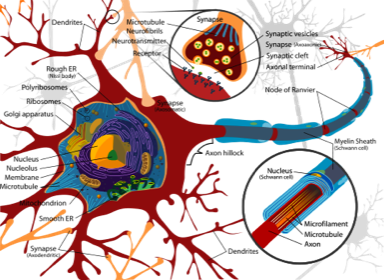Neurons!
Neurons
Humans have approximately 100 billion neurons that make up to around 1 quadrillion connections amongst themselves. Neurons are single cells that individually function yes/no relay stations. That is, each neuron receives information from it’s dendrites, and then the information gets processed by the nucleus. If the nucleus becomes ‘excited’ by the information, it attempts to tell connecting neurons about the information. However, if the nucleus is not excited about the information, the adjacent neurons never get to hear about it. So in effect, neurons are as much dams as they are are relay stations.
This is a typical neuron (see right). However, there are several variations to the basic shape. Regardless of the variation, most neurons have the same basic structure. Information is received by branches know was dendrites. Neurons can have several thousand dendrites — up to around 10,000. The dendrites take up around 90% of the surface area of each neuron. The dendrites connect to the cell body (soma) that houses the nucleus. Projecting from the nucleus is a single axon (basically, an electrical tube), which is insulated by myelin. The more myelin insulation, the quicker the electrical impulses travels to the end of the axon (and to the next neuron). Axons become better myelinated with heavy usage. That is, they have faster response times if they are used more often. Therefore, oft used networks of neurons have quicker response times if they are frequently used. This is why our learned skills get better and smoother over time and why old habits die heard (old habits are well myelinated networks; they easily trump competing networks).
Neurons to neuron communication is much more cumbersome than internal communication. When the electrical impulse reaches the and of the axon, it excites the endings known as the axon terminals. There through an electro-chemical process, neurotransmitters shot out the end of the axon terminal and swim across the synaptic gap — to the adjacent neuron, in the hopes of exciting that neuron’s nucleus. As if swimming across the synaptic gap weren’t cumbersome enough of a plan, each neurotransmitter has its own designated cleft design on the receiving end (dendrite of the next neuron). In effect, there is a special key hole for each specific key. Neurotransmitter A only fits into dendrite keyhole A. All in all, the system is remarkably similar to our own reproductive system; excitement is the keyword — it starts the entire process in motion, however, the process is highly dynamic and cumbersome.
Humans have approximately 100 billion neurons that make up to around 1 quadrillion connections amongst themselves. Neurons are single cells that individually function yes/no relay stations. That is, each neuron receives information from it’s dendrites, and then the information gets processed by the nucleus. If the nucleus becomes ‘excited’ by the information, it attempts to tell connecting neurons about the information. However, if the nucleus is not excited about the information, the adjacent neurons never get to hear about it. So in effect, neurons are as much dams as they are are relay stations.
This is a typical neuron (see right). However, there are several variations to the basic shape. Regardless of the variation, most neurons have the same basic structure. Information is received by branches know was dendrites. Neurons can have several thousand dendrites — up to around 10,000. The dendrites take up around 90% of the surface area of each neuron. The dendrites connect to the cell body (soma) that houses the nucleus. Projecting from the nucleus is a single axon (basically, an electrical tube), which is insulated by myelin. The more myelin insulation, the quicker the electrical impulses travels to the end of the axon (and to the next neuron). Axons become better myelinated with heavy usage. That is, they have faster response times if they are used more often. Therefore, oft used networks of neurons have quicker response times if they are frequently used. This is why our learned skills get better and smoother over time and why old habits die heard (old habits are well myelinated networks; they easily trump competing networks).
Neurons to neuron communication is much more cumbersome than internal communication. When the electrical impulse reaches the and of the axon, it excites the endings known as the axon terminals. There through an electro-chemical process, neurotransmitters shot out the end of the axon terminal and swim across the synaptic gap — to the adjacent neuron, in the hopes of exciting that neuron’s nucleus. As if swimming across the synaptic gap weren’t cumbersome enough of a plan, each neurotransmitter has its own designated cleft design on the receiving end (dendrite of the next neuron). In effect, there is a special key hole for each specific key. Neurotransmitter A only fits into dendrite keyhole A. All in all, the system is remarkably similar to our own reproductive system; excitement is the keyword — it starts the entire process in motion, however, the process is highly dynamic and cumbersome.


